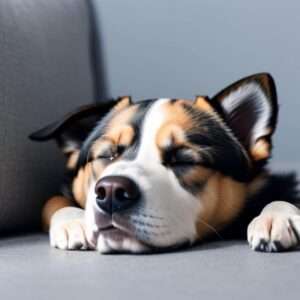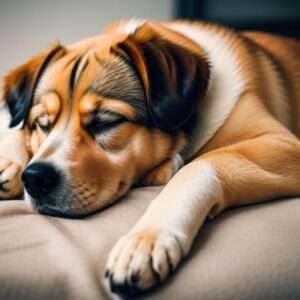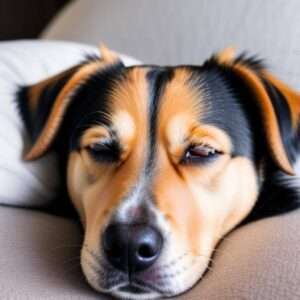Exploring Canine Sleep Patterns
Dogs spend a significant portion of their lives sleeping, and their sleep patterns can provide valuable insights into their overall health and well-being.
Why Do Dogs Eyes Roll Back When They Sleep?
 The sleep cycle in dogs involves eye movement, with the third eyelid, nictitating membrane, moving across the eye during sleep. This natural phenomenon, particularly during the Rapid Eye Movement stage, can indicate neurological issues or seizures, requiring veterinary attention. Observing and seeking professional advice is crucial for maintaining a healthy pet.
The sleep cycle in dogs involves eye movement, with the third eyelid, nictitating membrane, moving across the eye during sleep. This natural phenomenon, particularly during the Rapid Eye Movement stage, can indicate neurological issues or seizures, requiring veterinary attention. Observing and seeking professional advice is crucial for maintaining a healthy pet.
The Phenomenon of Eye Rolling in Dogs
One curious behavior observed in dogs during sleep is the rolling back of their eyes. This phenomenon has puzzled pet owners and veterinarians alike, leading to questions about its significance and underlying causes.
Insights into Rapid Eye Movement (REM) Sleep
To understand Why Do Dogs Eyes Roll Back When They Sleep, it’s essential to delve into the realm of REM sleep, a stage of sleep characterized by heightened brain activity and vivid dreams.
What is REM sleep?
REM sleep, or Rapid Eye Movement sleep, is a unique phase of the sleep cycle characterized by several distinct features:
- Rapid movement of the eyes: This occurs under closed eyelids and gives REM its name.
- Low muscle tone: Most muscles are relaxed to prevent acting out dreams.
- Vivid dreams: It’s the stage where dreams are most likely to occur.
- Brain activity: The brain is very active during REM sleep, with brainwave patterns similar to those when awake.
- Important for well-being: REM sleep plays a crucial role in memory consolidation, emotional processing, and brain development.
It typically starts about 90 minutes after falling asleep and recurs multiple times throughout the night, with longer periods occurring closer to morning. Adults generally need about two hours of REM sleep each night.
What is the difference between REM and NREM sleep?
REM (Rapid Eye Movement) and NREM (Non-Rapid Eye Movement) sleep are two distinct phases of the sleep cycle, each with unique characteristics and functions:
NREM Sleep:
- Stages 1-3 of the sleep cycle.
- Stage 1: Transition from wakefulness to sleep.
- Stage 2: Light sleep before deeper sleep, characterized by sleep spindles.
- Stage 3: Deep sleep, with slow delta waves; physical restoration occurs here.
REM Sleep:
- Stage 4 of the sleep cycle.
- Characterized by rapid eye movements, vivid dreams, and brain activity similar to wakefulness.
- Important for memory consolidation and emotional regulation.
The sleep cycle begins with NREM sleep, which transitions from light to deep sleep, followed by REM sleep. As the night progresses, the duration of REM sleep increases, and this cycle repeats several times. NREM sleep is more about physical repair, while REM sleep is more about cognitive functions and brain health.
The Role of Canine in Sleeping
 During REM sleep, dogs may experience dreams similar to humans, accompanied by rapid eye movements and physiological changes. So, the question why do dogs eyes roll back when they sleep when the experienced dreams.
During REM sleep, dogs may experience dreams similar to humans, accompanied by rapid eye movements and physiological changes. So, the question why do dogs eyes roll back when they sleep when the experienced dreams.
Understanding the Physiology of Dog Eyes
To comprehend why dogs’ eyes roll back during sleep, it’s crucial to grasp the unique anatomy and function of canine eyes.
Possible Explanations for Eye-Rolling Behavior
When arising this question in mind, why do dogs eyes roll back when they sleep Several theories attempt to explain why dogs exhibit eye rolling behavior during sleep, ranging from physiological responses to external stimuli to neurological processes.
Observing Sleep Behavior in Dogs
Careful observation of a sleeping dog’s behavior can provide valuable clues about their sleep cycles and the occurrence of eye-rolling. When your dog wakes up from a nap or if you gently lift their regular eyelid while they’re asleep, you might notice it. Why do dogs eyes roll back when they sleep Typically, their third eyelid is concealed in the corner of its eye. It may however, protrude and cover the cornea, giving the appearance that the eyes are rolled back.
Factors Influencing Eye Movements During Sleep
Various factors can influence the frequency and intensity of eye movements observed in sleeping dogs, including age, breed, and environmental stimuli. When someone asking you this question why do dogs eyes roll back when they sleep reply to them that this is a natural and harmless occurrence.
Addressing Concerns About Eye Rolling in Dogs
While eye rolling during sleep is generally considered normal behavior in dogs, certain signs may indicate underlying health issues that warrant further investigation. Universally the question around all of the pet owners why do dogs eyes roll back when they sleep this is happened When dogs are in a deep sleep, their muscles relax, including the muscles that control eye movement.
Common Misconceptions and Myths Debunked
Dispelling myths and misconceptions surrounding eye rolling in dogs can help pet owners better understand their furry companions’ sleep habits. Why do dogs eyes roll back when they sleep when questioning some people argued that this is the characteristics of every dogs but factors contributing to dogs’ eyes rolling back during sleep include Bell’s Phenomenon. This reflex action, discovered by Charles Bell in 1823, causes our eyeballs to roll upwards when we close our eyelids forcefully or passively (as we sleep).
Consulting a Veterinarian: When to Seek Advice
If pet owners have concerns about their dog’s sleep behavior or notice any unusual signs accompanying eye rolling, it’s essential to consult a veterinarian for guidance and support. When you questioned to any vegetarian why do dogs eyes roll back when they sleep, that the common answer of veterinarian it’s just part of their normal sleep cycle.
Tips for Ensuring Quality Sleep for Your Dog
Promoting healthy sleep habits in dogs involves creating a comfortable sleep environment, providing regular exercise, and maintaining a consistent bedtime routine.
Deciphering the Mysteries of Canine Sleep
While the phenomenon of dogs’ eyes rolling back when they sleep may seem mysterious, understanding the underlying physiology and behavior can shed light on this intriguing aspect of canine sleep. By observing and interpreting their furry friends’ sleep patterns, pet owners can deepen their bond with their dogs and ensure their well-being.
FAQs (Frequently Asked Questions)
 Q1: Is it normal for my dog’s eyes to roll back when they sleep?
Q1: Is it normal for my dog’s eyes to roll back when they sleep?
Answer: Yes, it’s generally considered normal for dogs’ eyes to roll back during sleep, especially during REM sleep, which is when dreaming occurs.
Q2: Should I be concerned if my dog’s eyes roll back excessively during sleep?
Answer: While occasional eye-rolling during sleep is normal, excessive or persistent eye-rolling may warrant further investigation by a veterinarian to rule out any underlying health issues.
Q3: Can dogs see when their eyes are rolled back during sleep?
Answer: No, dogs typically cannot see when their eyes are rolled back during sleep. Eye rolling is a natural physiological response that occurs during certain stages of the sleep cycle.
Q4: How can I create a comfortable sleep environment for my dog?
Answer: Providing a cozy bed, minimizing noise and distractions, and maintaining a consistent bedtime routine can help create a comfortable sleep environment for your dog.
Q5: When should I seek veterinary advice about my dog’s sleep behavior?
Answer: If you notice any unusual signs accompanying eye-rolling during your dog’s sleep, such as twitching, vocalization, or difficulty waking up, it’s advisable to consult a veterinarian for guidance and evaluation.
If you want to know more about Dog Breeders Spain please click here
